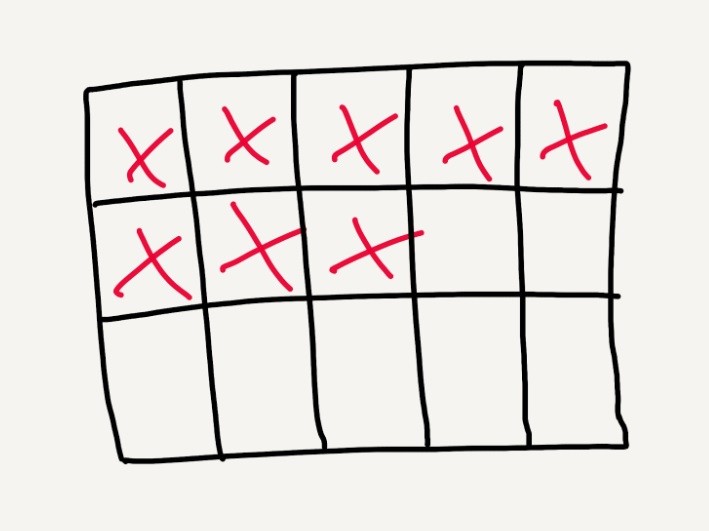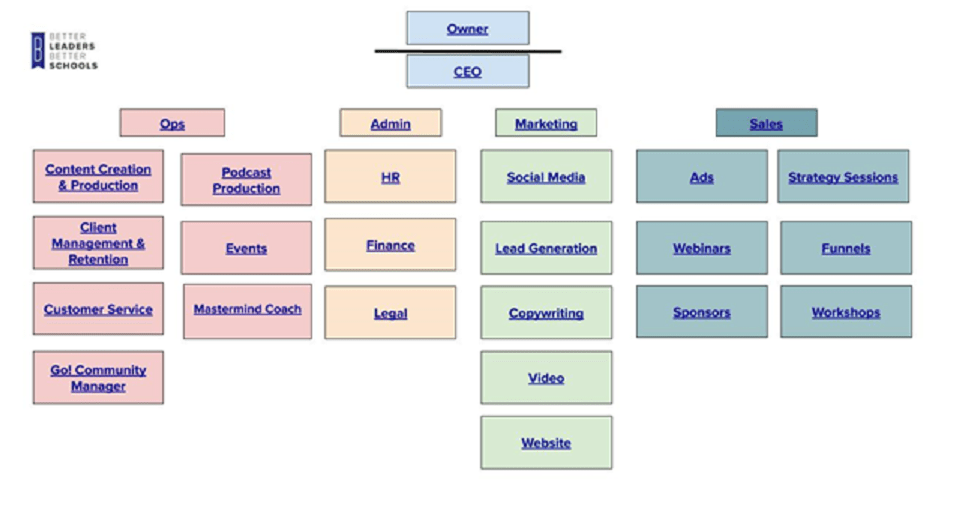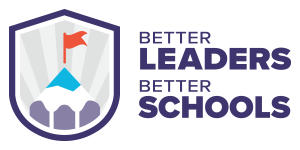Many leaders want a powerful 2020, but most won’t achieve that.
Three obstacles will get in the way:
- Doing the same thing they’ve done in the past (but expecting different results)
- Doing too much on their own
- Inconsistent execution
This list will help you get more done.
More importantly, it will help you get the right stuff done.
In this post, I’ll share 20 tips to making sure you have an amazing 2020.
These tips have worked for me and I promise if you implement them, they will work for you.
Deep vs shallow
There is a difference between deep and shallow work. Shallow work has to get done and helps you keep your job.
Deep work is magic. It creates world-class cultures that produce world-class results. Deep work gets you promoted.
Think about it this way … when you play poker, if you match the blind, that means you can continue playing the hand.
It doesn’t mean that you will actually win.
In order to win you have to make wise decisions and rely on sound strategy.
Shallow work is matching the blind. Deep work is winning the poker hand (and maybe even the tournament).
Action: Make a list of recurring tasks and projects that are coming up. Sort that list into deep vs shallow work. Prioritize.

The best way to guarantee you have a powerful year is to surround yourself with other leaders that have a similar passion and drive. Apply to the mastermind today!
Manage your meetings
You waste a lot of time in meetings.
If you’re the boss please cut it out!
You will be more productive and your people will love you.
Action: Answer the following questions:
- Would skipping or cutting this meeting hurt the project?
- If you do have to meet, can it be a standing meeting?
- Invitations matter: what is the minimum amount of people we need?
- How will you know if the meeting was a success? (choose before inviting)
- Does your meeting have more than one purpose? If it does, chuck it. Follow this advice: one meeting for one function.
Bonus tip: Estimate the amount of time a given meeting needs. Now plan it for half the time. Constraints are beautiful.
Backwards map
We tell our teachers to start with the end in mind. Leaders should do the same.
Just like defining what a successful unit or meeting looks like, what does a successful project look like before you start?
Once you know where you want to end up, make a plan to get there.
Action: Take one major project coming up and reverse engineer it.
Chunk it and sprint!
Now that you have your plan make it small.
You don’t eat an elephant in one bite, you eat an elephant one bite at a time.
Keep breaking your project down into smaller and smaller pieces so that is is doable.
Now it’s time to sprint. I typically like to work in 3 types of chunks:
- 12 week
- 1 week
- 1 day
Action: Break your project into the smallest doable segment.
All of these sprints are aligned to my goals which are ultimately aligned to my vision …
Align with your vision
Any work that is meaningful must be aligned with your vision.
Goals are abandoned when they don’t connect with both your head and your heart.
You can avoid this mistake by aligning your work with what drives you.
I wrote an epic blog post on creating a meaningful vision here.
If you’d benefit from meeting others and working with me live, I am gathering leaders in Taos, New Mexico to create their very own Vivid Vision.
Even if you’ve never created a vision (I’ll show you how to start) or if you are a vision-guru (I will reveal secrets that will make your vision 10x better).
Predetermine your “yes” and “no” list
Many leaders suffer from decision fatigue. As a result, they make poor choices simply because they are tired.
Other leaders want to avoid disappointing others or enjoy playing the martyr (I am a servant, dammit!) so they give and give even though they are running on empty. You can’t pour from an empty cup.
Conduct a Past Year Review (PYR) and figure out what your “yes” and “no” list will be this coming year.
Actions:
- Do a PYR
- Add more of the “Do more of this” to your calendar
- Post (and honor) your “Avoid at all costs” list.
The best way to guarantee you have a powerful year is to surround yourself with other leaders that have a similar passion and drive. Apply to the mastermind today!
Work from an ideal week
I like making choices before the need to make a choice arises.
That’s why you see some very influential people (think Steve Jobs) wearing the same thing over and over.
Black turtle neck and jeans anyone …

An ideal week is like wearing the same thing over and over. It’s one less decision to make on how you will invest your time.
An ideal week is designed categorically, helping leaders decide what “blocks” of time are most important each week.
They are written in pencil and can be revised.
After two weeks of working from an ideal week, here is what Erik, a current Superintendent, told me:
“I finally can relax on Sundays. I no longer worry about how I will spend my time next week. Now I’m able to focus on my family and I’ll get to the work stuff come Monday.”
Action: Create your ideal week.
Close open loops
If you ever have gotten up in the middle night and felt restless or if you struggle to be present with family and find that your mind continues to wander back to work, you probably suffer from open loops.
Open loops are all those pesky items on our to-do list that keep nagging at us and demanding our attention.
Closing open loops is actually an easy process and has the added benefit of adding peace to your life.
It’s easy to do.
Throughout the day when you think of something that needs to be done make sure you:
- assign it to a project or category (e.g. culture, instruction, leadership, etc.),
- assign a due date, and
- assign the person responsible for completing it (if that is not you).
I quickly do this by using an incredible app: Todoist.
Focus on lead indicators
If you want to lose weight in time for the beach, then it doesn’t make sense to let the scale tell you if you’re on track.
By the time you weigh yourself, it’s too late. This is a lag indicator.
In the Beach Bod case, you would want to focus on what you eat and how often/what kind of workouts you do each week. These examples are lead indicators.
By focusing on the inputs (rather than worrying and waiting for the output) you will achieve your goals. Another bonus is that you will be able to make adjustments on the fly if data tells you the tactics are not working.
A school example …
Let’s say you want to have 90% school attendance. We all know that the attendance percentage is going to go down throughout the year. We also know that if we wait until the end of the week, month, quarter, or year … it’s too late. There is no time to adjust.
Instead, the school should focus on what leads to a high attendance rate:
- Great instruction
- Positive relationships with kids and families
- Robust PBIS systems
- Communication home (early and often)
If we looked at those lead indicators (and measured them) the attendance rate would follow.
Action: Identify and focus only on lead indicators.
Keep score
I benefit from the discipline of keeping score every day. Each day I create a list in Trello of all the tasks I have to do aligned to my top goals.
(this post is an extensive post on my goal setting system)
I do this in an app called Trello.
In a card for the week I create a checklist for the day, which looks like this:

Every sports team keeps score. There are winners and losers.
Even though I’m playing an infinite game, I keep score to build momentum and hold myself accountable.
You should keep score too.
I’ve also found if I’m consistently scoring above 80% on task completion, I’m accomplishing more than I thought was possible and achieving more of my goals.
*Note: The Trello card above represent tasks aligned to my OKRs (or most important goals). This is not everything I do in a given day. Keeping track of that would be a waste of time. The goal is to focus on deep work.
Action: Keep score of your most important goals.
The best way to guarantee you have a powerful year is to surround yourself with other leaders that have a similar passion and drive. Apply to the mastermind today!
Do it in public
It’s easy to hide in private and much harder to hide in public.
This is why I write and podcast about my goals (and results).
It is also why I message my team in Slack on what I intend to accomplish and if I did what I said I would do.
The message is simple. It’s not an explanation of everything I’m up to (my team has access to my Trello OKR board). It’s simply for accountability and quick communication.

In the mastermind, we regularly discuss our OBT (one big thing) and update the team on our progress. Even if you’re not in our mastermind, how much more productive would you be if you told your team what you set out to do each day (and if you actually got there)?
Action: Share your goals in public.
Do it together
“If you want to go fast, go alone.
If you want to go far, go together.”
– African Proverb
One reason the mastermind is the world’s greatest PD for school leaders is that we connect isolated leaders within a thriving community.
So you should join the mastermind.
Or at the very least, connect with others in your PLN so that you can far instead of going fast.
Form a group focused on getting more done this year. Set a time to regularly meet (2x a month minimum). Meet for 30-60 minutes to check-in, update the team on progress, and problem solve any challenges you’re having related to the project.
Action: Meet consistently with a trusted group of advisors and you will accomplish more.
Use a timer
We hide in private and we also hide by giving ourselves too much time to accomplish a task or ship a project.
Start using a timer. The timer should be set aligned to your blocks of time established in your ideal week (discussed above).
Once the timer is done, you’re done.
Using a timer establishes urgency and helps you focus. I like working in 60-90 minute chunks on writing (like this). Smaller tasks get 5-30 minute sprints.
Action: Set a timer and stop when it goes off.
Define “good enough”
A final way to hide is behind perfectionism. Without a timer, there is always more work to do. Without defining “good enough” there is also more work to do.
As a struggling perfectionist, this was a hard lesson to learn.
By defining what is good enough before starting a project, I have an easier time walking away (even when I know I can add a bit more …. Tweaking this sentence … adding this image, etc.).
Defining good enough has allowed me to focus on what really matters.
A message on social media is different than this blog post, which is different than the book I am working on.
If I treat them all equally, I’ll be paralyzed by perfectionism.
A school example …
School Improvement Plans. Who really looks? Who really cares? How often do they really guide the work of your school?
If your experience was like mine as a principal, why do you put so much time there?
Another example …
Teacher evaluation systems and data. If your school uses a framework like Danielson or Marzano, those tools are beasts!
And I don’t think the evaluation tool really improves instruction.
You know what does improve instruction? Meaningful conversations that follow frequent observations.
Action: Define good enough. Give “C, D, and F” effort to tasks that don’t really matter and save your best for what does.
Cut the fat
Look at the entirety of a project or task and noodle on this interesting question: What can I cut that would improve the project in a major (or maybe minor) way?
Can you think of 10 ways you could make the project better by making it smaller?
Small leads to speed …
Which leads to shipping ….
Which leads to making change happen.
Action: Make your project smaller (not in terms of impact, but in terms of features).
The best way to guarantee you have a powerful year is to surround yourself with other leaders that have a similar passion and drive. Apply to the mastermind today!
Get in the zone
This will look different for everyone, but there are a few triggers I like to use to foster creativity and productivity.
Each morning I journal. I follow a specific format and once I’ve done that I can progress through the day.
My mind has received a signal that the day is off to a great start.
The next step is to make a cup of coffee which I bring to my desk and power up my laptop. I limit myself to two glasses of coffee before switching to tea and then drink water for the rest of the day.
I’ve lived in many cold climates (Chicago, Antwerp, Haarlem, Glasgow) and I recently read about Hygge. Another trigger is burning candles when I work and need to be creative.
Finally, I either work in silence or sometimes use an app called Brain.fm and set it for 60 minutes. The music is designed to help me “get in the zone” and once the music stops playing I get up from my desk and take a short break.
Action: Figure out a routine that will work for you and trigger that it’s time to work.
Eat the frog
I never read the book but I live by the idea.
Do the hard stuff first.
The only time I ignore this rule is if I’m putting off something that is of low-value (like an email or a bill).
I know that I work best in the morning, so I keep that time protected for my most important work.
Don’t break the chain
One way to be more productive is to write jokes like Seinfeld.
When asked how he is so funny, Jerry answered that he writes jokes every day. When he does that he draws a big red X on the calendar.
The secret is to avoid breaking the chain.
Consistency leads to trusting yourself and momentum. Don’t break the chain.
Action: Choose a habit or task to track. Don’t break the chain.

Turn It into a Process
If you can turn a task into a process, that means you can delegate it.
If you can delegate it, that means you don’t have to do it.
If you don’t have to do it, that means you can do only the things you are able to do.
It takes time and a lot of time to empower others to do tasks you are already doing. It’s also very much worth the effort.
A process document doesn’t have to be complicated. You really need to answer just three things:
- Define the process.
- Identify the trigger.
- Note all the steps.
In addition to a document, you might create videos of how you do the work.
I’m currently using a tool called Vidyard. I use the free plan.
Remember the idea I shared earlier, “Start with the end in mind”? Here is the big picture.
This is my business on one page:

This could be your organization.
Each box is a category and role. Within each role is hyperlinked a job description. From the job description are linked process documents.
If I wanted to sell BLBS to you, I could do so with integrity knowing that you’d buy a profitable business.
In the context of school, what does your org look like on one page? What are all the roles and processes that need to happen for your staff and students to experience success?
If I can hire for key positions within BLBS I can focus on coaching, content creation, and growth. Processes are important and help you increase productivity.
Action: Create a process document for a recurring task that you can hand off in the next 2 weeks.
Turn off notifications
This one will take no time at all and will save you loads of time in the future.
Turn off notifications across all your devices. Pop-ups and sounds that alert you to updates and messages are enemies of productivity.
A study done by Microsoft found that distracted workers took an average of 15 minutes to get back to work. Switching tasks and purposely multitasking is a terrible idea if you want to be productive
The best way to guarantee you have a powerful year is to surround yourself with other leaders that have a similar passion and drive. Apply to the mastermind today!


